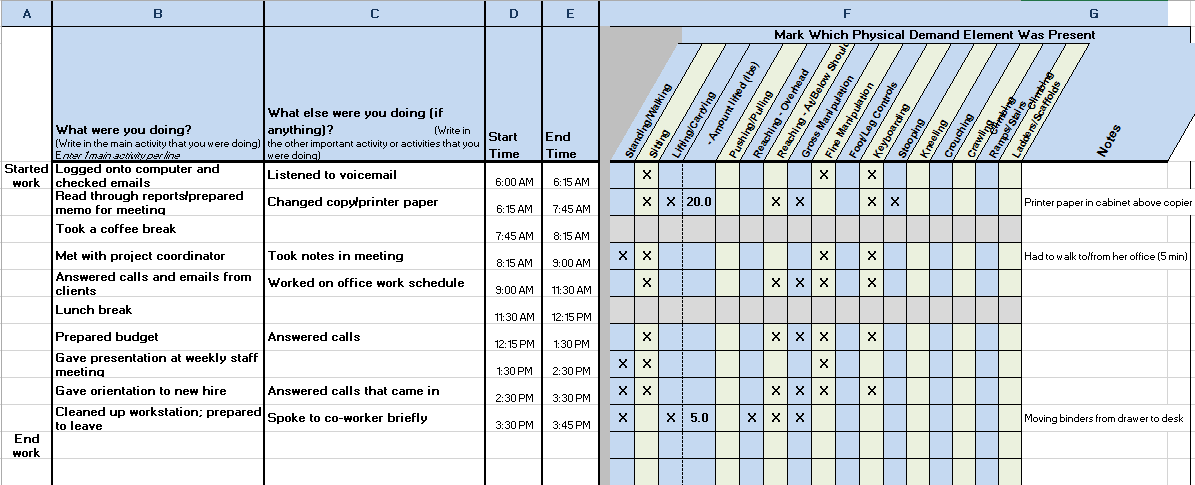Attachment B - Inc Diary Instructions
Cognitive and Psychological Research
Attachment-B_ORS Incumbent Diary Instructions_7-25-16
ORS Incumbent Survey Development Test
OMB: 1220-0141
ORS Incumbent Survey Diary
U.S. DEPARTMENT OF LABOR
Bureau of Labor Statistics

Your
Occupational Requirements
|
|
|
|
Thank you for participating in the Occupational Requirements Survey (ORS) Employee Survey!
The information you record in this diary will help us understand more about the cognitive and physical demands of different types of jobs in the United States.
By law (Title 5 of Public Law 107-347), we must keep your information confidential; we use it for statistical purposes only.
If you have comments regarding this survey, please send them to the Office of Compensation Levels and Trends,
2 Massachusetts Ave., N.E., Room 4175, Washington, D.C. 20212
Please record your work tasks for the following period: _(Day of Week)__/_ (Date) _____
If you have any questions, please call:
Field Economist’s name:
|
Telephone: |
Study Team Member name:
|
Telephone: |

Purpose of ORS
ORS is a new federal survey designed to provide information about work-related requirements found in jobs in the United States. The Bureau of Labor Statistics (BLS) conducts this survey under an agreement with the Social Security Administration (SSA). The information that you provide in this diary will help the SSA make fair decisions in its disability programs, which currently provide financial help to more than 14 million disabled individuals and 2 million eligible dependents. For more information about ORS, visit: http://www.bls.gov/ors/
Filling Out Your ORS Diary
Complete this diary on your assigned day/date (see previous screen and/or the invitation email you received from BLS for your assigned date).
Enter a brief description of each main work task that you perform during your assigned day, in the order in which you performed those tasks (Column B of the diary).
A Task is a distinct activity assigned to or performed by workers in an occupation that results in a meaningful outcome.
The diary allows you to report the duration of work tasks in 15-minute increments. Select the Start and End times for each task using the drop-down menus in Columns D and E of the diary.
If you performed any other important, secondary work tasks while doing your main task, write a brief description of that task (or tasks) in Column C of the diary.
Use the Notes field (Column G) to provide any additional details or explanations for your entries (e.g., descriptions of any items lifted or carried).
If you are unsure about whether to include an activity or where to record it, write it down wherever it seems best or make a note and ask your Field Economist.
View an example of a completed diary (see Figure 1, page 4).
We recommend that you make your diary entries periodically throughout your assigned day (e.g., every 2 hours) rather than waiting until the end of the day to complete your diary.
For each row in the diary, also mark which Physical Demands you were required to perform during your work task(s) (using the grid provided in Section F of the diary).
Please review the definitions and visual examples of the Physical Demands (link here to material below) BEFORE you complete your diary.
NOTE: you DO NOT need to mark the Physical Demands for any personal/non-work activities that occur during your diary day (e.g., breaks, lunch, personal calls).

NOTE: ORS is designed to capture requirements based on the way jobs are typically performed, and is NOT focused on the specific skills or experience of the worker. As you complete this survey, please follow these guidelines:
Base your answers on how you generally perform your work, meaning the way in which you normally complete your assigned duties, tasks, and responsibilities.
Base your answers on how your work is performed without accommodation. Accommodations are modifications that an employer makes to meet the needs of an individual worker with a disability or other work constraints.
Figure 1. Example of Completed ORS Employee Diary


The ORS Physical Demands data elements provide a way of describing the physical activities that an occupation requires of a worker. These elements focus on the physical demands of the job - not the physical capacities of the worker. Physical Demand refers to the level and/or duration of physical exertion generally required to perform occupational tasks (sitting, standing, walking, lifting, carrying, reaching, pushing, and pulling).
This section offers a general overview and basic description of the Physical Demand elements.
Climbing Ramps/Stairs |
||
|
|
|
Ascending or descending ramps and/or stairs using feet and legs. Hands and arms may be used for balance (e.g., to hold a railing). Note: Stairs involved in commute/getting into building are excluded if work is always performed in one building. Stairs onto a vehicle or a piece of machinery/equipment are included. |
||
Climbing Ladders/Ropes/Scaffolding |
|
Ascending or descending ladders, scaffolding, ropes, poles and the like using feet/legs and/or hands/arms. |
Crawling |
|
Moving about on hands and knees or hands and feet. |
Crouching |
|
Bending body downward and forward by bending legs and spine. |
Fine Manipulation |
|
Picking, pinching, or otherwise working primarily with fingers rather than the whole hand or arm as in gross manipulation. |
|
Use of one or both feet or legs to move controls on machinery or equipment. Controls include, but are not limited to, pedals, buttons, levers, and cranks. |
Gross Manipulation |
|
Seizing, holding, grasping, turning, or otherwise working with hand(s). It is often present when lifting involves the hands. Note: Fingers are involved only to the extent that they are an extension of the hand to hold or operate a tool such as tin snips or scissors. |
Keyboarding |
|
Entering text or data into a computer or other machine by means of a keyboard. Devices include traditional keyboard, 10-key pad, touch screen and other. |
Kneeling |
|
Bending legs at knees to come to rest on knee(s). |
Lifting/Carrying |
|
Lifting is to raise or lower an object from one level to another (includes upward pulling). Carrying is to transport an object – usually by holding it in the hands or arms, but may occur on the shoulder. |
Pushing/Pulling |
|
Pushing/pulling may involve use of hands/arms, feet/legs, and/or feet only done with one side of the body or both sides. Pushing - Exerting force upon an object so that the object moves away from the force. Pulling - Exerting force upon an object so that the object moves toward the force. |
Reaching Overhead |
|
Extending arms with the hand higher than the head and one of these conditions exist: (1) A person bends the elbows, and the angle at the shoulders is about 90 degrees or more, or (2) A person keeps the elbow extended, and the angle at the shoulder is about 120 degrees or more. |
Reaching At/Below Shoulder |
|
Reaching at or below the shoulder is present when there is ‘Reaching,’ but it does not meet the threshold for ‘Overhead.’ ‘Overhead’ and ‘At/Below the Shoulder Reaching’ can be present in the same task. |
Stooping |
|
Bending the body downward and forward by bending the spine at the waist. |
Additional Occupational Characteristics
In addition to completing your employee diary, you will be asked some background information about your current job. We include these questions below for your review, but please submit your responses through the online survey tool at the same time you complete your diary.
What is the title of your job?


Does your job have any responsibility for accomplishing tasks by directing others? Yes No
If yes, which of the following statements best describes the responsibility for directing others?

Lead: I have authority to make, coordinate or review the work assignments of employees performing the same general work as me on a day to day basis.

Supervisor: I have the authority, in the interest of the company, to hire, transfer, lay off, promote, reward or discipline other employees.


How is your job classified by your employer? Full-time Part-time


How many hours per day do you typically work under this classification?
How many hours per week do you typically work under this classification?

How many weeks per year do you typically work under this classification?
Example: Some workers in full-time jobs work 8 hours per day, 40 hours per week, and 52 weeks per year.


Is your job represented by a labor union? Yes No


Do you receive performance pay? Yes No
Examples of performance pay: commissions, production bonus, piece rate or other incentives based on production or sales.

Occupational Cognitive (Mental) Demands
This next group of questions focuses on information about the intellectual and mental demands of your job. Select the option that best describes your job requirements.
If you would like to see an example of how the level of decision-making is coded, click here.
Decision-making
Decision-making measures the type and scope of decisions you are expected to make. It is common for jobs to include a range of decision making.

What is the highest level of independent judgment you are expected to use for your job?
I use independent judgment to select from a limited number of predetermined actions.
I use independent judgment to determine the most appropriate course of action in situations that do not have set responses.
I use independent judgment to make decisions by choosing from a large number of possibilities in situations where a high degree of uncertainty or complexity may exist.
Work Review
Work Review measures the frequency at which a machine, supervisor, or lead worker checks your work to ensure performance standards are being met. Work review can occur in person or remotely.
What is the highest frequency of work review that you receive under normal circumstances?

More than once per day

Once per day

At least once per week, but less than daily

Less than weekly
Pace
Pace is the physical and cognitive speed needed to perform work tasks. Pace can be the actual rate required to complete repetitious tasks, or the rate at which you are expected to respond to a variety of incoming projects.
There are two components to ‘Pace’:
Pace of work: measures the rate at which you must process new or incoming information, or take physical action based on new information.
Controlling workflow: means that you can prioritize work tasks or adjust the amount of time it takes to complete them.


Are there faster and slower periods of work? Yes No

What is the fastest pace performed?
Rapid with no periods of waiting

Steady with rare periods of waiting

Unhurried with much time spent observing or waiting, rushed periods rarely or never occur
Can you intervene and control the flow of work?

Yes, I can change the priority of work tasks or the amount of time allotted to complete them.

No, my work is primarily driven by business processes, production line speed, or customer demands.
Adaptability
Adaptability measures characteristics of your job that cause you to adjust to changes in work routines in the following areas: work tasks, work schedule, and work location.
Work tasks: are your regular duties. A change in work task requires that you remember new instructions, procedures, or similar information.

What is the highest rate of change in work tasks that you experience on your job?
At least once per day

At least once per week, but less than daily

At least once per month, but less than weekly

Less than monthly, including never
Work Schedule: is the regular recurring work hours and days that are set by your employer. To be considered a change in the work schedule, the change must be directed your employer.

 Does
your work schedule ever change? Yes No
Does
your work schedule ever change? Yes No
Work Location: is the physical site where you work. A change in work location is a change to a new work site or from a discontinued work site. Changes in work location may accompany changes in work tasks or schedule.

What is the highest rate of change in work location change that you experience on your job?
Does not change unless it is permanent

Changes up to four times a year

Changes more than four times a year
Work-related Personal Interactions
Work-Related Personal Interactions measures your requirement to cooperate with others, handle conflict, and respond to social cues, requests, and criticism. There are two types of work-related personal interactions:
Regular contacts: are those people with whom you have an established working relationship. Examples of regular contacts include:
Co-workers, supervisors, and managers with whom you regularly work
Clients, customers or students you see on a regular basis
Other contacts: are those people with whom you have no established working relationship, including the public.
What is the highest level of work-related verbal interactions that you have with contacts?

Regular Contacts Other Contacts



Constantly, every few minutes

More than once per hour, but not constantly

More than once per day, but not more than once per hour


No more than once per day, includes never
What is the highest level of work-related interactions that you have with contacts?
Regular Other









Exchanging straightforward, factual information
Coordinating work with others; solving recurring problems with cooperative parties
Some gentle persuading or soft-selling; discussing
Influencing; hard-selling; asserting control in situations

Resolving controversial or long-range issues; defending; negotiating
| File Type | application/vnd.openxmlformats-officedocument.wordprocessingml.document |
| Author | Scott Fricker |
| File Modified | 0000-00-00 |
| File Created | 2021-01-27 |
© 2026 OMB.report | Privacy Policy



















